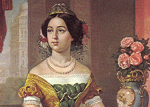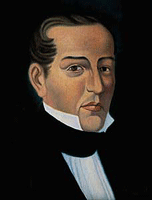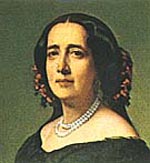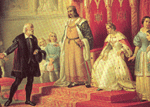Notes
on Latin American Romanticism
1825–1875
During the middle 50 years
(roughly speaking) of the 19th century the principal humanities
movement in Latin America is that of Romanticism. This movement was fairly
derivative from European Romanticism, but this period also shows a late
continuation of Neoclassical tendencies with elements imported especially from
Generally speaking, Romanticism
in Europe occurs closer to the beginning of the 19th century than in
During this period Latin American
painting focused on themes of local color, idealized scenes of the countryside,
significant historical events, and portraits. One fine example of the latter is
the 1855 portrait of the wife of the flamboyant Mexican general and long-term
president, Santa Anna, Dolores Tosta de Santa Anna.
Given the fact that Latin America
emerged from the wars of independence poor, disorganized, and suffering from
death and destruction, it should come as no surprise that politicians and
humanists alike produced prose essays and prose fiction (i.e., the novel) as the
primary means of expression in this their first semi-independent cultural
project. Novelists especially learn about social and political rebellion in the
worldwide cultural movement of Romanticism, and they then live it in their own
countries. In
Among the most prominent writers
in this period are:
(1) José María Heredia (1803-1839),
the prominent Cuban poet of the prototypical Romantic movement; he spend many
years of his life in exile in the United States and Mexico due to his support
for Cuban independence from Spain; three of his most famous poems are “Himno del desterrado,” “En el teocalli de Cholula,” and the very
famous “Niágara,” which is a long
Romantic hymn-like poem celebrating the natural force and beauty of Niagara
Falls. For the poem and the Study Questions on Heredia, see: => “En el teocalli de Cholula.”
Here's a portrait of the poet:
|
|
(2) Argentinian novelist José Mármol, who wrote about the Argentinian civil war
and the dictator Juan Manuel Rosas in his novel Amalia (1851);
(3) Colombian writer Jorge Isaacs, whose novel María (1867) is a
typically Romantic sentimental love narrative;
(4) Cuban Cirilo Villaverde's slave abolitionist novel Cecilia Valdés (1892);
(5) The historical novel Enriquillo (1882) about the extermination of
the indigenous people of Hispaniola by Manuel Jesús Galván, who was from the
Dominican Republic;
(6) Domingo Faustino Sarmiento (1811-1888), who wrote the historical essay Vida de Juan Facundo Quiroga (1845). The
political novel in
Domingo
Faustino Sarmiento's outstanding book is a historical analysis in literary
style about the conflict, which Sarmiento reduces to a battle between
civilization and barbarism (civilización
y barbarie). This theme of the binary opposition between violence on the
one hand and "civilization" (i.e., peace, high culture, progress,
republican democracy, industrialization, etc.) on the other hand, as first
proposed by Sarmiento, has been used my many, though not all, scholars—both
Latin Americans and others—as a convenient scheme for describing Latin America.
In Facundo, Sarmiento uses the
Argentinian gaucho as a typical representative of "barbarism"; i.e.,
a totally individualistic, violent, mysterious, incomprehensible enemy of
civilization who lives in the vast hinterland of the pampas. The horse is the
gaucho's quasi-mythical symbol according to this scheme. There is a
contradiction in this analysis, however, for Sarmiento sees the essence of
Argentinian nationalism in the autochthonous character of the rugged
individualists who inhabit the open plains of the interior regions. Sarmiento
was educated in the traditions of French neoclassical encyclopedism; for him
Rosas was the symbol of barbarity; but Sarmiento also saw the gaucho warlord
Facundo as the quintessential representative of the brute force of the pampas
that was opposed to civilization. In this sense, then, Sarmiento's book
contains a forshadowing of conflicts within Latin American self-consciousness
and historical reality. (For an image of gauchos see these slides: Opening Slide Show #XX and #XXX.)
José
Mármol
(1817-1871), who lived in exile in
The Colombian writer Jorge Isaacs (1837-1895) produced
perhaps the most quintessentially romantic work of
The most versatile of all Latin
American humanists during this period is the Venezuelan polymath Andrés Bello (1781-1865), who published
major prose works in the humanities, law, philosophy, education, and philology.
His most well known work is theCastilian Grammar Intended for the Use by
Americans (1847). In addition, however, he was an accomplished poet in the
vein that bridged the modes of Neoclassicism and Romanticism. Another important
Romantic poet from Latin America is the Cuban José María Heredia (1803-1839),
who also bridges the transition from Neoclassicism to Romanticism.
For a representative figure of
this movement, click on the following image of the Cuban poet Gertrudis Gómez de Avellaneda
(1814-1873). She was born in Camagüey, Cuba, but she moved to Spain
definitively in 1836, except for a visit back to Cuban from 1859 to 1863. She
wrote plays, novels, short fiction narratives, letters, and poetry.
Transition
to Modernism and the Twentieth Century (1850-1900)
During the latter part of the
Romantic Period the work of Latin American humanists transitioned into what one
could call Romantic Realism (realismo
romántico). As this phrase implies, Latin American romantics were
influenced by the European developments that have been called
"realist". Writers such as Stendhal, Balzac, Flaubert, Dickens,
Dostoevsky, Turgenev, Tolstoy, and Pérez Galdós, and painters such as Corot,
Courbet, and Daumier influenced their counterparts in
When
Latin American artists began painting historical subjects, they were slow to
break entirely from European themes, but, given the criollo society for which
they painted, painters at mid-century often injected
One visual example of the use of
realism to depict key historical moments is this painting that depicts the
results of a tragic War of the Triple Alliance in
As Blanes' painting suggests,
during the transition period, various fields of the Latin American humanities
focused history. Notable in these fields is the historical novel. With the rise
of a rudimentary middle class, fitful political developments, the introduction of
industrialization in major urban areas, and early national efforts at improving
education, a growing number of people became passionate consumers of
literature. The historical novel began at this time. In it readers enjoyed
descriptions legends, superstitions, duels over offended honor, revenge, erotic
intrigue, and daily life in the old colonial times. Novelists were influenced
by European writers such as Sir Walter Scott, Victor Hugo, Alexandre Dumas, and
Alessandro Manzoni. The Latin American historical novel in general tends toward
works that are theorizing and preaching rationalist liberalism. They read like
plodding documentaries at the same time that they can be melodramatic and
sentimental. The prevalence of politics, adventure, and heroism, however, can
be seen as preparing the ground for the so-called novel of the Mexican
Revolution (1910-1920). When the Latin American novel enters the twentieth
century the writers are also witnesses and participants in the historical
dramas which serve as the core subject matter of their works. They write to
discharge a sense of personal responsibility vis-à-vis the separate countries
and their fellow citizens.
As a corollary or sub-genre to
the historical novel, we also find a number of novels whose aim was to idealize
native Americans (i.e., Indians). Latin American writers such as Clorinda Matto
de Turner (1854-1909) found inspiration for this kind of work in European
authors such as Jean-Jacques Rousseau and François-René de Chateaubriand, who
idealized American natives whom these French writers thought of as being both
primitive and ideal. Latin Americans used indigenous words, traditions, both of
which enriched the European-based language and discourse Spanish-Americans,
French-Americans, and Portuguese Americans had inherited from their respective
"mother countries". Matto de Turner was a Peruvian woman whose
writings were as combative as they were prolific. She expressed vigorous
denunciations against the infra-human conditions of exploited Peruvian native
peoples. Although nowadays the plots in her works seems weak (e.g., impossible
love stories, absurd action), nevertheless there is power in her fictional
campaigns for social justice.
Although it is not one of the
most distinctive of the humanities movements in







